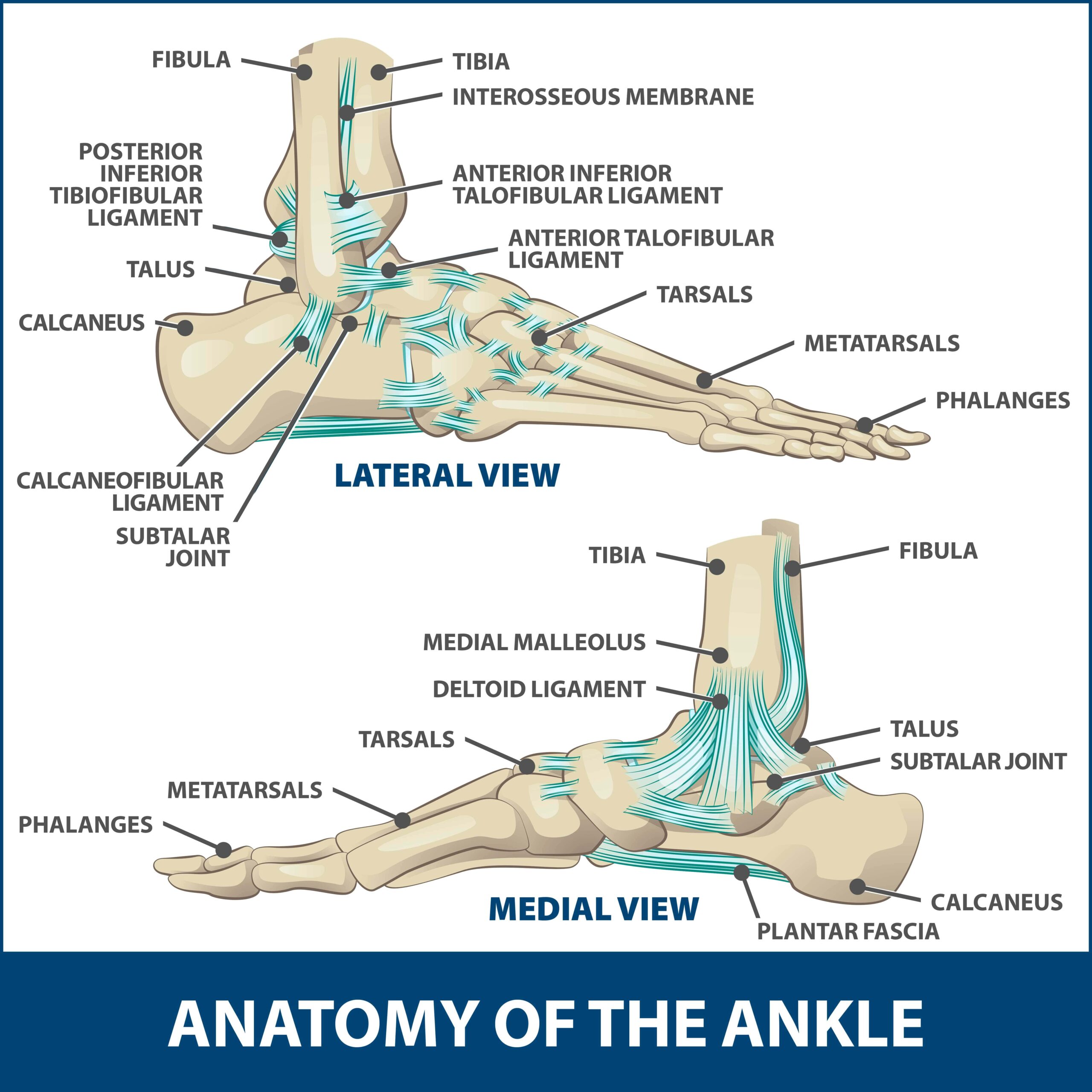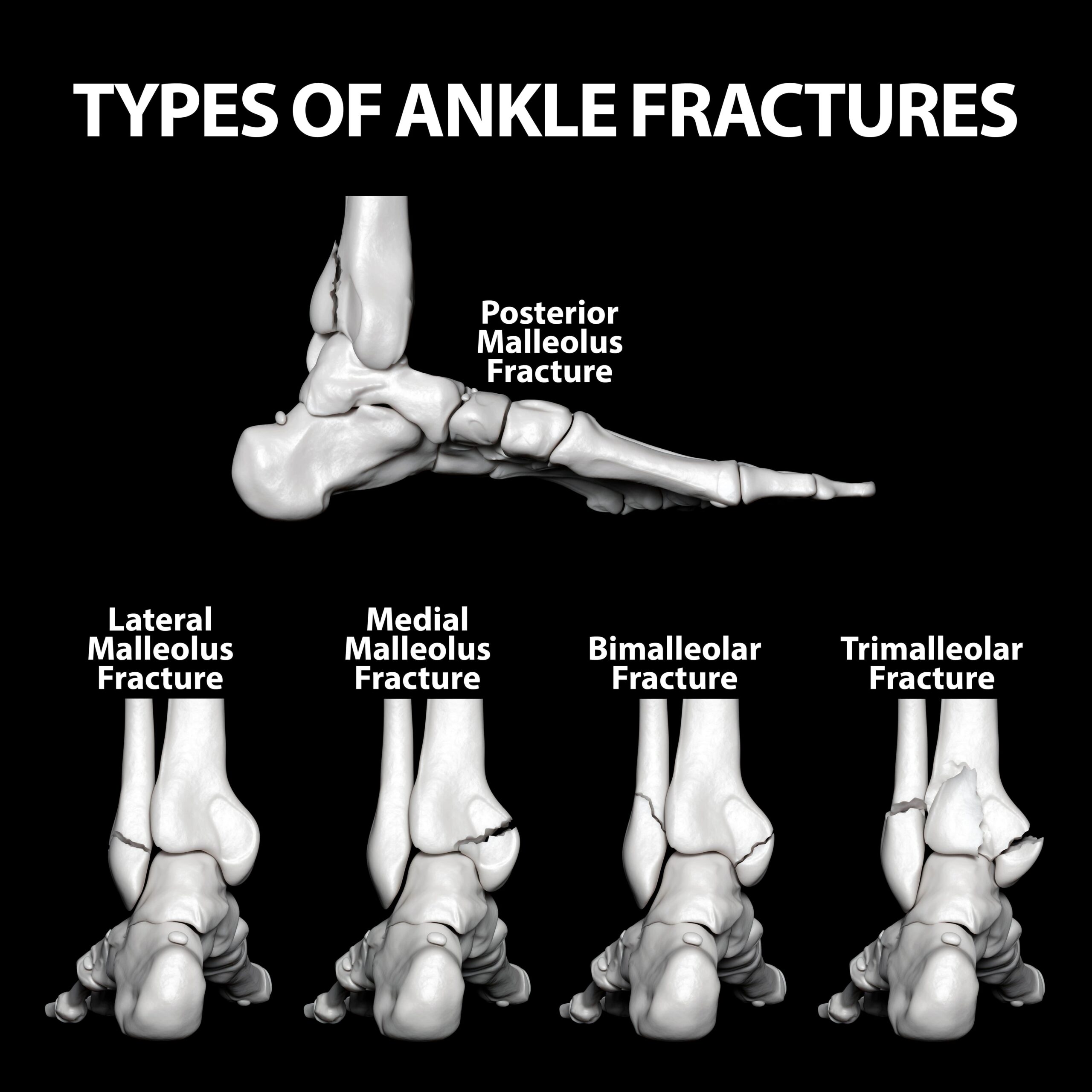Ankle Fracture Surgery
OVERVIEW
A broken ankle (also known as an ankle fracture) occurs when one or more of the bones that make up the ankle joint are broken. There are three different bones in your ankle that can break. Sometimes two or all three of your ankle bones can break at once. Depending on the severity and number of broken bones in your ankle, you may need surgery. While surgery for broken ankles varies depending on your specific fracture, all involve using screws and other devices to help stabilize the bones and allow them to heal in the correct position.
ANATOMY
Your foot bones are divided into three parts: the hindfoot, midfoot, and forefoot. Seven bones, known as tarsals, make up the hindfoot and midfoot. The calcaneus (heel bone) is the largest of the tarsal bones in the foot. It lies at the back of the foot (hindfoot) below the three bones that make up the ankle joint. These three bones are the:
- Shinbone (Tibia)
- Smaller bone in the lower leg (Fibula)
- Small foot bone that works as a hinge between the tibia and the fibula (Talus)
Together, the calcaneus, heel bone, and the talus form the subtalar joint. The subtalar joint allows side-to-side movement of the hindfoot and is especially crucial for balance on uneven surfaces.

DESCRIPTION
A broken ankle is also known as an ankle fracture. It happens when one or more of the bones that makes up the ankle joint are broken. A broken ankle can range from a simple break in just one of the bones to several fractures. The more bones that are broken, the more unstable the ankle becomes. There may be ligaments damaged as well. The ligaments of the ankle hold the ankle bones and joint in position. Depending on the type and severity of your ankle injury, you may not be able put weight on your ankle for a few months and possibly may need surgery.
Several things may cause you to break your ankle, such as:
- Twisting or rotating your ankle.
- Tripping or falling.
- Rolling your ankle.
- Impact during a car accident (or other forceful event).
There are several different types of fractures that each involve special surgical procedures. The different types of fractures are:
- Lateral Malleolus Fractures are fractures of the fibula bone in the ankle.
- Posterior Malleolus Fractures are fractures of the back of the tibia at the level of the ankle joint. A lateral malleolus fracture may also accompany them.
- Medial Malleolus Fractures are fractures of the tibia at the inside of the lower leg.
- Bimalleolar Fractures are fractures where two of the three parts of the ankle are broken.
Trimalleolar Fractures occur when all 3 of the bones in your ankle break.

SYMPTOMS
Several common symptoms characterize a broken ankle, such as:
- Immediate and severe pain.
- Swelling.
- Bruising.
- Tender to touch.
- Deformity (usually happens if the ankle joint is dislocated as well).
- Inability to put any weight on the injured foot.

SURGICAL PROCEDURE
During a Lateral Malleolus Fracture surgery (fracture of the fibula bone in the ankle), the bone fragments are first repositioned (also known as reduced) into their normal position. They are held together with special screws and metal plates attached to the outer surface of the bone. In some cases, a screw or rod inside the bone may be needed to keep the bone fragments together while they heal.
For a Posterior Malleolus Fracture (fracture of the back of the tibia at the ankle joint), the back of the ankle may be unstable depending on how large the broken piece is. To fix this, screws may be placed from the front of the ankle to the back, or vice versa. Another option is to place screws along the back of the shin bone.
During a Medial Malleolus Fracture surgery (fracture of the tibia at the inside of the lower leg), a bone graft may be needed to act as scaffolding for the new bone to grow on if the fracture is impacted. An impacted fracture results with one bone being driven into the other one, typically due to a high force. Depending on the fracture, the bone fragments may be fixed using screws, a plate and screws, or different wiring techniques to help keep the bones in place.
For Bimalleolar Fractures (when two of the three parts of the ankle are broken), they are treated surgically with the before listed corresponding procedures. The exact surgery your surgeon will perform is dependent on which bones are broken.
Trimalleolar Fractures are when all three parts of your ankle are broken. Each of the fractures can be treated with the same surgical techniques before mentioned for each fracture.
RECOVERY
Because there is such a wide range of injuries, there is also a wide range of how people heal after their injury. It takes at least six weeks for the broken bones to heal. It may take longer for any of the surrounding ligaments and tendons to heal.
You will also need to go through a rehabilitation program of physical therapy to help regain strength and flexibility in your ankle. Your Florida Orthopaedic Institute physician will help determine what program you should follow to help you recover quickly and safely.
NEXT STEPS
Contact your Florida Orthopaedic Institute physician today to learn more about ankle fracture surgeries.
Areas of Focus
- Foot, Ankle & Lower Leg
- Achilles Tendinitis - Achilles Insertional Calcific Tendinopathy (ACIT)
- Achilles Tendon Rupture
- Achilles Tendonitis
- Ankle Fracture Surgery
- Ankle Fractures (Broken Ankle)
- Ankle Fusion Surgery
- Arthroscopic Articular Cartilage Repair
- Arthroscopy Of the Ankle
- Bunions
- Charcot Joint
- Common Foot Fractures in Athletes
- Foot Stress Fractures
- Hallux Rigidus Surgery - Cheilectomy
- Hammer Toe
- High Ankle Sprain (Syndesmosis Ligament Injury)
- Intraarticular Calcaneal Fracture
- Lisfranc Injuries
- Mallet, Hammer & Claw Toes
- Metatarsalgia
- Morton’s Neuroma
- Neuromas (Foot)
- Orthopedic Physician Or A Podiatrist? Definition of a Podiatrist
- Plantar Fasciitis
- Sports Foot Injuries
- Sprained Ankle
- Total Ankle Replacement
- Turf Toe
Specialties
- AC Joint Injuries
- Achilles Tendinitis - Achilles Insertional Calcific Tendinopathy (ACIT)
- Achilles Tendon Rupture
- Achilles Tendonitis
- ACL Injuries
- Ankle Fracture Surgery
- Ankle Fractures (Broken Ankle)
- Ankle Fusion Surgery
- Anterior Cervical Corpectomy & Discectomy
- Arthroscopic Articular Cartilage Repair
- Arthroscopic Chondroplasty
- Arthroscopic Debridement of the Elbow
- Arthroscopy Of the Ankle
- Articular Cartilage Restoration
- Artificial Disk Replacement (ADR)
- Aspiration of the Olecranon Bursa - Fluid In Elbow
- Atraumatic Shoulder Instability
- Avascular Necrosis (Osteonecrosis)
- Bankart Repair
- Basal Joint Surgery
- Bicep Tendon Tear
- Bicep Tenodesis
- Bone Cement Injection
- Bone Growth Stimulation
- Bone Health Clinic
- Broken Collarbone
- Bunions
- Bursitis of the Shoulder (Subacromial Bursitis)
- Calcific Tendinitis of the Shoulder
- Carpal Tunnel Syndrome
- Charcot Joint
- Chiropractic
- Clavicle Fractures
- Colles’ Fractures (Broken Wrist)
- Common Foot Fractures in Athletes
- Community Outreach
- Cubital Tunnel Syndrome
- De Quervain's Tenosynovitis
- Deep Thigh Bruising
- Degenerative Disk Disease
- Diffuse Idiopathic Skeletal Hyperostosis (DISH)
- Discectomy
- Discitis Treatment & Information
- Dislocated Shoulder
- Dupuytren’s Disease
- Elbow
- Elbow Bursitis
- Elbow Injuries & Inner Elbow Pain in Throwing Athletes
- Epidural Injections for Spinal Pain
- Finger Dislocation
- Flexor Tendonitis
- Foot Stress Fractures
- Foot, Ankle & Lower Leg
- Foraminotomy
- Fractured Fingers
- Fractures Of The Shoulder Blade (Scapula)
- Fractures Of The Tibial Spine
- Functional Nerve Transfers of The Hand
- Ganglion Cysts
- General Orthopedics
- Glenoid Labrum Tear
- Golfer's Elbow
- Groin Strains and Pulls
- Growth Plate Injuries Of The Elbow
- Hallux Rigidus Surgery - Cheilectomy
- Hammer Toe
- Hamstring Injuries
- Hand & Finger Replantation
- Hand & Wrist
- Hand Nerve Decompression
- Hand Skin Grafts
- Hand, Wrist, Elbow & Shoulder
- Heat Injury/Heat Prostration
- High Ankle Sprain (Syndesmosis Ligament Injury)
- Hip & Thigh
- Hip Arthroscopy
- Hip Dislocation
- Hip Flexor Strains
- Hip Fractures
- Hip Hemiarthroplasty
- Hip Impingement Labral Tears
- Hip Muscle Strains
- Hip Pointers and Trochanteric Bursitis
- Hyperextension Injury of the Elbow
- Iliopsoas Tenotomy
- Iliotibial Band Syndrome
- Impingement Syndrome of the Shoulder
- Interlaminar Implants
- Interlaminar Lumbar Instrumental Fusion: ILIF
- Interventional Pain Management
- Interventional Spine
- Intraarticular Calcaneal Fracture
- Joint Replacement
- Knee & Leg
- Kyphoplasty (Balloon Vertebroplasty)
- Kyphosis
- Labral Tears Of The Hip (Acetabular Labrum Tears)
- Laminectomy: Decompression Surgery
- Lateral Collateral Ligament (LCL) Injuries
- Lisfranc Injuries
- Little League Shoulder
- LITTLE LEAGUER'S ELBOW (MEDIAL APOPHYSITIS)
- Lumbar Epidural Steroid Injection
- Lumbar Interbody Fusion (IBF)
- MACI
- Mallet, Hammer & Claw Toes
- Medial Collateral Ligament Injuries
- Meniscus Tears
- Metatarsalgia
- Minimally Invasive Spine Surgery
- Morton’s Neuroma
- Muscle Spasms
- Muscle Strains of The Calf
- Nerve Pain
- Neuromas (Foot)
- Neurosurgery
- Olecranon Stress Fractures
- Orthopaedic Total Wellness
- Orthopaedic Trauma
- Orthopedic Physician Or A Podiatrist? Definition of a Podiatrist
- Osteoarthritis of the Hip
- Osteoporosis
- Outpatient Spine Surgery
- Partial Knee Replacement
- Patellar Fracture
- Pelvic Ring Fractures
- Peripheral Nerve Surgery (Hand) Revision
- Pinched Nerve
- Piriformis Syndrome
- Piriformis Syndrome
- Plantar Fasciitis
- Plastic Surgery
- Podiatry
- Primary Care Sports Medicine
- Quadriceps Tendon Tear
- Radial Tunnel Syndrome (Entrapment of the Radial Nerve)
- Revascularization of the Hand
- Reverse Total Shoulder Replacement
- Rheumatoid Arthritis (RA) of the Shoulder
- Rheumatoid Arthritis Of The Hand
- Robotics
- Rotator Cuff Tears
- Runner's Knee
- Sacroiliac Joint Pain
- Sciatica
- Scoliosis
- Senior Strong
- Shin Splints
- Shoulder
- Shoulder Arthritis
- Shoulder Arthroscopy
- Shoulder Injury: Pain In The Overhead Athlete
- Shoulder Replacement
- Shoulder Separations
- Shoulder Socket Fracture (Glenoid Fracture)
- SLAP Tears & Repairs
- Spinal Fusion
- Spine
- Spondylolisthesis and Spondylolysis
- Sports Foot Injuries
- Sports Hernias (Athletic Pubalgia)
- Sports Medicine
- Sports Wrist and Hand Injuries
- Sprained Ankle
- Sprained Wrist Symptoms and Treatment
- Subacromial Decompression
- Sudden (Acute) Finger, Hand & Wrist Injuries
- Targeted Muscle Reinnervation (TMR)
- Tendon Transfers of The Hand
- Tennis Elbow Treatment
- Thigh Fractures
- Thigh Muscle Strains
- Thumb Ulnar Collateral Ligament Injuries
- Total Ankle Replacement
- Total Hip Arthroplasty
- Total Hip Replacement - Anterior Approach
- Total Knee Replacement Surgery
- Trapezius Strain (Muscle Strain of The Upper Back)
- Traumatic Shoulder Instability
- Tricep Pain & Tendonitis
- Trigger Finger
- Turf Toe
- UCL (Ulnar Collateral Ligament) Injuries
- Ulnar Neuritis
- Valgus Extension Overload
- Vertebroplasty
- WALANT (Wide Awake Local Anesthesia No Tourniquet)
- Whiplash and Whiplash Associated Disorder (WAD)
- Wound Care
- Wrist Arthroscopy
- Wrist Fractures
- Wrist Tendonitis
Services
- Physical Medicine & Rehabilitation
- Physical Therapy
- Primary Care Sports Medicine
- PROMs (Patient-Reported Outcome Measures)
- Same-Day Orthopaedic Appointments Now Available
- Sports Medicine
- Sports-Related Concussion Treatment
- Telehealth Page
- Telemedicine
- Workers' Compensation
- Workers' Compensation Dispensary
- X-Ray
